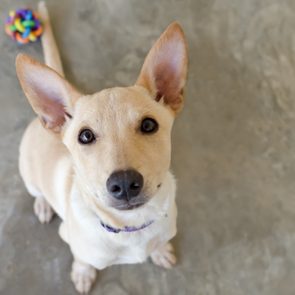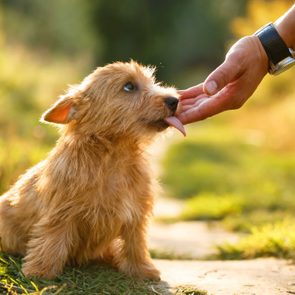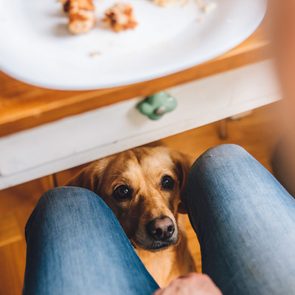Why Do Dogs Eat Grass? 7 Common Reasons—and How to Stop It
Updated: Jun. 06, 2024
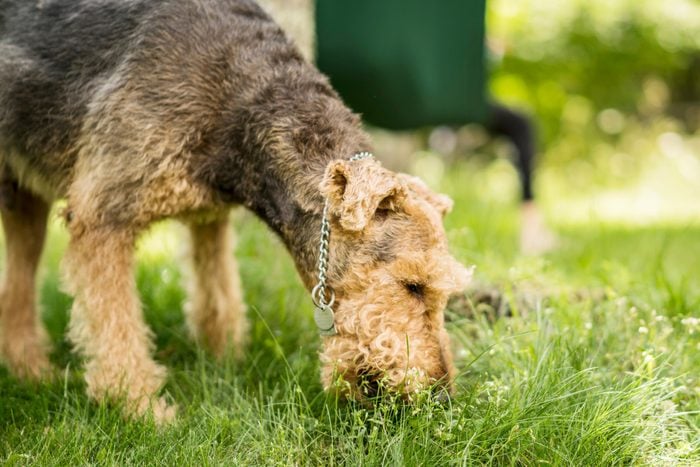
Many dogs like to eat grass from time to time. Here’s when it’s cause for concern.
We’ve all seen how livestock, including cows, sheep and goats, love gnawing on grass. It’s fine for grazing to be their pastime because their stomachs are able to digest all the cellulose in grass. Unlike those animals, dogs are omnivores, related to meat-eating hunters like wolves. Yet if you own a dog, you may have seen it snacking on grass while out in your backyard or on a walk. So why do dogs eat grass? Is your dog not getting enough food? Could it be sick? Or is it another puzzle springing from weird-yet-normal dog behavior?
It turns out that different dogs eat grass for different reasons. Let’s take a look at the most likely ones.
Get Reader’s Digest’s Read Up newsletter for more pet insights, humor, cleaning, travel, tech and fun facts all week long.
What does it mean if your dog eats grass? 7 Most common reasons your dog is eating grass
1. It’s in their DNA
Though we think of canines as historically carnivorous, they actually evolved as omnivores that would eat whatever was available, including vegetation. Also, the prey animals that our dogs’ ancestors would eat were usually herbivores, so those wild dogs were indirectly consuming plant life. Instinct is a pretty logical answer to “Why do dogs eat grass?” A much less understandable dietary habit, on the other hand, is why dogs eat its own poop.
2. A form of pica is behind it
The urge to eat substances other than food is a condition called pica. While pica is a cause for concern in people, it’s usually nothing more than a sign of boredom in dogs. To make your dog’s day less ho-hum, add a few minutes to your regular walks, take him into your backyard or to a dog park for a fetch session.
3. They just like it
Why do dogs eat grass, specifically? Your pup could simply like the taste or texture of grass, in the same way we enjoy munching on celery sticks once in a while. “They [may] find it palatable and need to add roughage to their diet,” Katy Nelson, DVM, a senior veterinarian at Chewy, tells Reader’s Digest. Tender spring grass may be particularly delectable to them.
4. They need fiber
If your dog eats a lot of grass, you might want to take a look at his diet. It could be a sign that he isn’t getting enough fiber and, as a result, is seeking out roughage to eat. Just like humans, dogs need fiber to help them digest their food and pass stool regularly.
5. Their diet is low in a nutrient
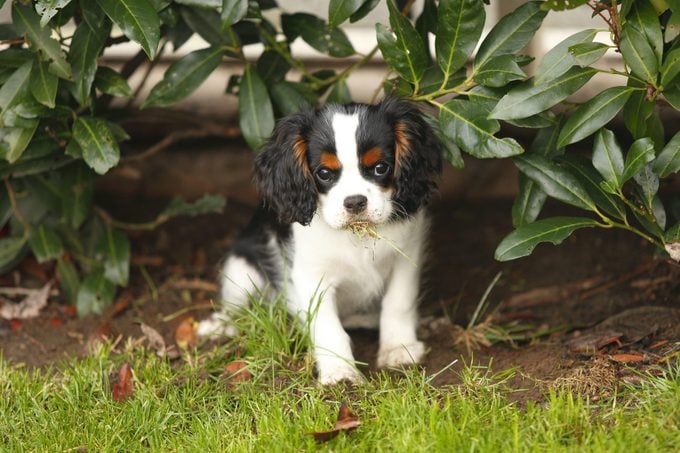
While this is less likely to be the case if your dog is eating a high-quality, well-balanced diet, regularly eating grass can be a sign of a vitamin or mineral deficiency. If grass noshing has become a daily habit for your dog, especially if you’ve recently switched dog foods, it’s worth a call to your vet to go over what and how much you’re feeding him.
6. It’s like a natural antacid
Your pup can’t pop a Tums, so when his tummy is upset, he may chew on grass. Bile can build up as your dog’s stomach becomes empty, which can be irritating and uncomfortable. Eating grass can release the bile. Many dog owners have seen this in action after their dog suddenly eats grass like crazy, vomits and then suddenly appears happier and more energetic. Those pet parents swear this is the answer to “Why do dogs eat grass?” However, at least as many dogs don’t vomit after eating grass as do, so this dynamic clearly only applies to some.
7. Your dog is thirsty
Like most types of vegetation, grass has a high water content. If your dog is eating grass primarily early in the morning or late in the evening, when the grass has dew on it, this could be the reason behind it. This may also be the case if he nibbles on grass only on hot summer days. Make sure your dog always has a bowl of fresh water available both inside your home and in the yard.
Will eating grass harm your dog?
Fortunately, nibbling on grass every once in a while won’t harm your pet. That said, many lawns are treated with pesticides, which can be toxic to dogs. And even if the yard in question is chemical free, your dog may be swallowing intestinal parasites, from feces left behind by other animals, along with that clump of grass.
How can I stop a dog from eating grass?
So, at the end of the day, a more important question to answer than “Why do dogs eat grass?” is “How do I stop my dog from eating grass?” We asked celebrity dog trainer Chrissy Joy about this, and she provided some helpful strategies for thwarting the grass chomping.
1. Manage your dog’s outdoor activity
First and foremost, Joy recommends consulting your vet if your dog is acting different and eating a ton of grass, as it could be a sign of something medical afoot. If your pup’s bill of health is A-OK, she says managing your dog’s outdoor activity is a logical next step. “Keep your dog on a 6-foot leash and help manage the time your dog gets to sniff the grass so it doesn’t go further into eating it,” she explains. “Use treats and rewards to help encourage your dog to leave the grass alone and find a tastier reward from you.” If you need help with this management, work with a professional dog trainer.
2. Supervise potty breaks and walks
If your dog is constantly eating grass and you want them to stop, one strategy to consider is supervising their potty breaks and walks. That means leashing your dog during their potty time so you can see—and redirect—the behavior. This also gives you the chance to reward your dog more often for not eating grass.
3. Keep your dog busy in the yard
Let’s be real—most dogs love being outside, and you’ll want your pup to roll around in the grass as much as possible when the weather’s nice. If your dog will be in the grass for a while, and they have a tendency to nibble on it, Joy recommends finding ways to keep them busy so they have less time for snacking. “There are several fun DIY puzzle toys and feeders, such as snuffle mats, which can help redirect a dog’s curious mindset,” she says. If you give them a puzzle toy, hide bits of kibble or doggy-safe human foods inside it. These activities provide physical and mental stimulation and can distract your pup from the grassy delicacy.
Next, read up on the foods dogs can’t eat.
About the experts
- Katy Nelson, DVM, is a senior veterinarian at Chewy. She’s been a vet for more than two decades and has experience in both general and emergency veterinary settings. She’s based in Alexandria, Virginia, with her family, which includes two fur babies.
- Chrissy Joy is a celebrity dog trainer, live performer and International Trick Dog Champion who has been featured on PIX11 and The Tonight Show with Jimmy Fallon, as well as in USA Today. Her goal is to inspire others to develop their bond with their pup through activities like trick training.


















